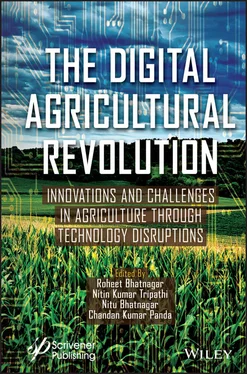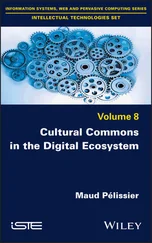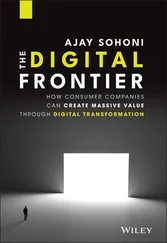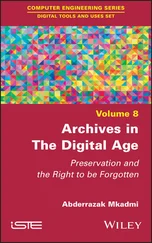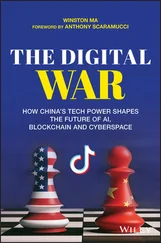1 Cover
2 Title Page The Digital Agricultural Revolution Innovations and Challenges in Agriculture through Technology Disruptions Edited by Roheet Bhatnagar Nitin Kumar Tripathi Nitu Bhatnagar and Chandan Kumar Panda
3 Copyright
4 Preface
5 1 Scope and Recent Trends of Artificial Intelligence in Indian Agriculture 1.1 Introduction 1.2 Different Forms of AI 1.3 Different Technologies in AI 1.4 AI With Big Data and Internet of Things 1.5 AI in the Lifecycle of the Agricultural Process 1.6 Indian Agriculture and Smart Farming 1.7 Advantages of Using AI in Agriculture 1.8 Role of AI in Indian Agriculture 1.9 Case Study in Plant Disease Identification Using AI Technology—Tomato and Potato Crops 1.10 Challenges in AI 1.11 Conclusion References
6 2 Comparative Evaluation of Neural Networks in Crop Yield Prediction of Paddy and Sugarcane Crop 2.1 Introduction 2.2 Introduction to Artificial Neural Networks 2.3 Application of Neural Networks in Agriculture 2.4 Importance of Remote Sensing in Crop Yield Estimation 2.5 Derivation of Crop-Sensitive Parameters From Remote Sensing for Paddy and Sugarcane Crops 2.6 Neural Network Model Development, Calibration and Validation 2.7 Conclusion References
7 3 Smart Irrigation Systems Using Machine Learning and Control Theory 3.1 Machine Learning for Irrigation Systems 3.2 Control Theory for Irrigation Systems 3.3 Conclusion and Future Directions References
8 4 Enabling Technologies for Future Robotic Agriculture Systems: A Case Study in Indian Scenario 4.1 Need for Robotics in Agriculture 4.2 Different Types of Agricultural Bots 4.3 Existing Agricultural Robots 4.4 Precision Agriculture and Robotics 4.5 Technologies for Smart Farming 4.6 Impact of AI and Robotics in Agriculture 4.7 Unmanned Aerial Vehicles (UAV) in Agriculture 4.8 Agricultural Manipulators 4.9 Ethical Impact of Robotics and AI 4.10 Scope of Agribots in India 4.11 Challenges in the Deployment of Robots 4.12 Future Scope of Robotics in Agriculture 4.13 Conclusion References
9 5 The Applications of Industry 4.0 (I4.0) Technologies in the Palm Oil Industry in Colombia (Latin America) 5.1 Introduction 5.2 Methodology 5.3 Results Analysis 5.4 Colombia PO Industry 5.5 The PO Industry and the Circular Economy 5.6 Conclusion 5.7 Further Recommendations for the Colombian PO Industry Acknowledgments References
10 6 Intelligent Multiagent System for Agricultural Management Processes (Case Study: Greenhouse) 6.1 Introduction 6.2 Modern Agricultural Methods 6.3 Internet of Things Applications in Smart Agriculture 6.4 Artificial Intelligence 6.5 MAS 6.6 Design and Implementation 6.7 Analysis and Discussion 6.8 Conclusion References
11 7 Smart Irrigation System for Smart Agricultural Using IoT: Concepts, Architecture, and Applications 7.1 Introduction 7.2 Irrigation Systems 7.3 IoT 7.4 IoT Applications in Agriculture 7.5 IoT and Water Management 7.6 Introduction to the Implementation 7.7 Analysis and Discussion 7.8 Conclusion References
12 8 The Internet of Things (IoT) for Sustainable Agriculture 8.1 Introduction 8.2 ICT in Agriculture 8.3 Internet of Things in Agriculture and Allied Sector 8.4 Geospatial Technology 8.5 Summary and Conclusion References
13 9 Advances in Bionic Approaches for Agriculture and Forestry Development 9.1 Introduction 9.2 Precision Farming 9.3 Powerful Role of Drones in Agriculture 9.4 Nanobionics in Plants 9.5 Role of Nanotechnology in Forestry 9.6 Conclusion References
14 10 Simulation of Water Management Processes of Distributed Irrigation Systems 10.1 Introduction 10.2 Modeling of Water Facilities 10.3 Processing and Conducting Experiments 10.4 Conclusion References
15 11 Conceptual Principles of Reengineering of Agricultural Resources: Open Problems, Challenges and Future Trends 11.1 Introduction 11.2 Modern Agronomy and Approaches for Environment Sustenance 11.3 International Federation of Organic Agriculture Movements (IFOAM) and Significance 11.4 Low Cost versus Sustainable Agricultural Production 11.5 Change of Trends in Agriculture References
16 12 Role of Agritech Start-Ups in Supply Chain—An Organizational Approach of Ninjacart 12.1 Introduction 12.2 How Does the Chain Work? 12.3 Undisrupted Chain of Ninjacart During Pandemic-19 12.4 Conclusion References
17 13 Institutional Model of Integrating Agricultural Production Technologies with Accounting and Information Systems 13.1 Introduction 13.2 Research Methodology 13.3 The General Model of a New Informational Paradigm of Agricultural Activities’ Organization 13.4 The Model of Institutional Interaction of Information Agents in Agricultural Production 13.5 Conclusions References
18 14 Relevance of Artificial Intelligence in Wastewater Management 14.1 Introduction 14.2 Digital Technologies and Industrial Sustainability 14.3 Artificial Neural Networks and Its Categories 14.4 AI in Technical Performance 14.5 AI in Economic Performance 14.6 AI in Management Performance 14.7 AI in Wastewater Reuse 14.8 Conclusion References
19 15 Risks of Agrobusiness Digital Transformation 15.1 Modern Global Trends in Agriculture 15.2 The Global Innovative Differentiation 15.3 National Indicative Planning of Innovative Transformations 15.4 Key Myths and Risks of Digitalization of Agrobusiness 15.5 Examples of Use of Digital Technologies in Agriculture 15.6 Imperatives of Transforming the Region into a Cost-Effective Ecosystem of Digital Highly Productive and Risk-Free Agriculture 15.7 Conclusion References
20 16 Water Resource Management in Distributed Irrigation Systems 16.1 Introduction 16.2 Types of Mathematical Models for Modeling the Process of Managing Irrigation Channels 16.3 Building a River Model 16.4 Spatial Hierarchy of River Terrain 16.5 Organizations in the Structure of Water Resources Management 16.6 Conclusion References
21 17 Digital Transformation via Blockchain in the Agricultural Commodity Value Chain 17.1 Introduction 17.2 Precision Agriculture for Food Supply Security 17.3 Blockchain Technology Practices and Literature Reviews on Food Supply Chain 17.4 Agricultural Sector Value Chain Digitalization 17.5 Conclusion References
22 18 Role of Start-Ups in Altering Agrimarket Channel (Input-Output) 18.1 Introduction 18.2 Agriculture Supply Chain Management 18.3 How Start-Ups Fill the Concerns and Gaps in Agri Input Supply Chain? 18.4 Output Supply Chain 18.5 How Start-Ups are Filling the Concerns and Gaps in Agri Output Supply Chain? 18.6 Conclusion References
23 19 Development of Blockchain Agriculture Supply Chain Framework Using Social Network Theory: An Empirical Evidence Based on Malaysian Agriculture Firms 19.1 Introduction 19.2 Literature Review 19.3 Methodology 19.4 Results and Discussion 19.5 Conclusion 19.6 Acknowledgment References
24 20 Potential Options and Applications of Machine Learning in Soil Science 20.1 Introduction: A Deep Insight on Machine Learning, Deep Learning and Artificial Intelligence 20.2 Application of ML in Soil Science 20.3 Classification of ML Techniques 20.4 Artificial Neural Network 20.5 Support Vector Machine 20.6 Conclusion References
25 Index
26 Wiley End User License Agreement
1 Chapter 1 Table 1.1 Distinguishing feature of subfields of AI.
2 Chapter 2 Table 2.1 Land use of the study area in the year 2014–2015. Table 2.2 Sample normalized input data of FFBPNN yield estimation model of paddy... Table 2.3 Sample and training result of FFBPNN yield prediction model of paddy c... Table 2.4 Statistical analysis of neural network training and testing of season ...
3 Chapter 3 Table 3.1 Abbreviations of machine learning techniques. Table 3.2 Recent machine learning practices of the irrigation systems. Table 3.3 Abbreviations of control theory techniques. Table 3.4 Recent control theory applications of the irrigation systems. Table 3.5 Aforementioned remote control extensions for irrigation systems.
Читать дальше
